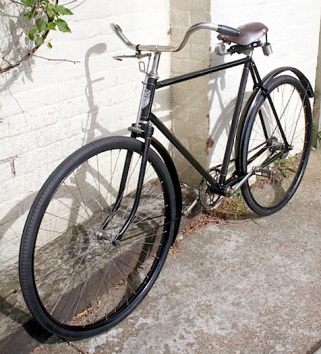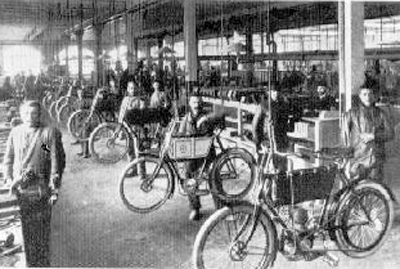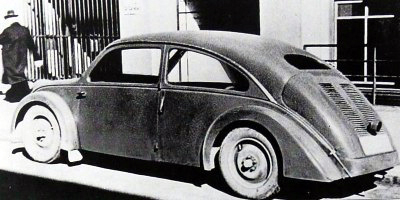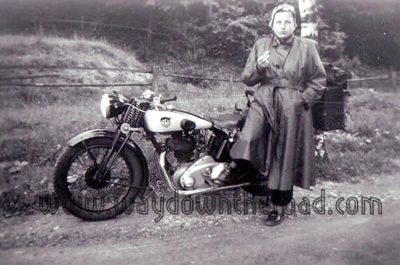PAGE 47. German Cyclemotors: The NSU Quickly & NSU History
NSU Quickly 1953-1968
The NSU Quickly was the ‘Cyclemotor Killer’
So what was all the fuss about?
Essentially, it was a superb design for its day and was launched right at the beginning of the ‘moped onslaught’ of 1954.
It was a fast machine with a 2-speed gearbox. Even though customers might not have realized at the beginning how reliable the engine was, it still set such an impossibly high standard for moped design that it killed off the cyclemotor instantly.
One of the most attractive aspects for buyers was the excellent back-up service worldwide.
Interestingly, it was described in the 1955 advert above as a ’49cc streamlined autocycle’ – the term ‘moped’ had not been adopted yet. Notice how ‘NSU lecture and service vans tour the country.’ And those vans were Volkswagens: NSU could be considered the moped equivalent of the VW, a ‘volksmoped.’
******************************************************************************************
1955 NSU Quickly
This is a 1955 NSU Quickly that I owned for a couple of years until I sold it in Summer 2007 to Geoffrey in New Zealand. It’s pictured next to my VW Splitscreen.
Early Quicklys (or should that be Quicklies?) are the bargain of 2008/2009. Though their prices are much higher in Germany, in the UK it’s still possible to pick one up at a cheap price. They will not stay cheap for long.
******************************************************************************************
1966 NSU Quickly
I still own this 1966 Quickly.
Although the earlier models are more ‘desirable’ I’ve owned enough over the past 25 years to choose what attracts me personally rather than what I think others might prefer.
This particular one is in excellent unrestored condition, just how I like them.
The advantage of a later Quickly such as this is a more solid centre stand. Later models also had dual-seats and 3 speeds. To my mind a 1960s Quickly is the most practical vintage moped to own if you want to use it regularly.
******************************************************************************************
The NSU Quickly engine used various design features of the German DKW engine, which set the 2-stroke design standard pre-war, and which was copied by the British motorcycle industry after the War for many of its own products.
A particular DKW innovation was the ‘Loop Scavenging Principle.’
The principle of 2 – stroke engines uses 2 or more transfer ports to loop fresh air/petrol/oil mixture up the side of the cylinder and down the other pushing the burnt exhaust ahead of it and out the exhaust port. In contrast to the uniflow cycle Loop scavenging is more powerful and efficient as the backside of the piston is used like a pump to fill the combustion room. Loop Scavenging was invented by A. Schnuerle for DKW who were exclusive users of the patent and is today found on any 2 stroke engine.
******************************************************************************************
1958 NSU Quickly Model L
As I commented on Page 45, the Meister Super Luxus appeared in 1956, two years before the Quickly-L and, as they look so similar, I assume NSU must have based their Model L on the Super Luxus design.
As it says in the advertising brochures for the Quickly L, NSU had made half a million Quicklys by the time this model was launched.
That made the Quickly the most successful moped to date (subsequently surpassed by the Honda 50 in the 1960s).
The enclosed bodywork of the ‘L’ was the result of demand for ‘scooterettes’ which were essentially mopeds with extra bodywork to make them look more like scooters. These were particularly popular in Belgium.
The Quickly-L is my favourite of NSU’s various mopeds – and the only Quickly model that I’ve not yet owned. If you have one for sale, please let me know!
Finally, if you are fed up with walking (according to the advertising blurb) but can’t afford a Quickly-L, there are still the two simpler versions of this luxury model, the Quickly-N (or Standard) and Quickly-S (de Luxe).
These two brochures illustrate what the 3 models have in common. In fact, what they are trying to tell us (but in a ‘sales speak’ type of way) is that the Model L is just the same moped with a bit of extra bodywork.
******************************************************************************************
******************************************************************************************
NSU Cycle-Attachment Engine – the Motosulm 1931-1935
It is not widely known in the UK that NSU made a cycle-attachment engine.
Although they didn’t manufacture ‘hilfsmotor’ engines after the War like many of their competitors, they were one of the first German companies to recognize the potential for one in the 1930s, and their 63cc front-mounted engine was introduced in 1931.
With 12.5 million cyclists on the road in Germany by the end of the 1920s, a ‘help-motor’ (the literal translation of the German term for cyclemotor – ‘hilfsmotor’) seemed a viable proposition.
The NSU factory was by the River Sulm. When, in 1931, NSU had a competition to select a name for their new cyclemotor, the eventual choice was ‘Motosulm.’
It’s unusual to see a delivery bicycle with a front-mounted engine (above). The NSU Delivery Cycle Model 101 had its front carrier raised higher to allow for the fitting of the Motosulm engine. However, once the front basket was loaded (capacity 75kg) the bicycle was impossible to steer! Only a few experimental models of this version were made.
The 1934 Motosulm pictured above sold recently on American ebay for $2700. The ‘damenrad’ (Ladies Bike) model illustrated below is from 1932.
Production of the Motosulm ended in 1935, when the 98cc NSU Quick was introduced.
******************************************************************************************
NSU Quick 1935-1953
The NSU Quick was the successor to the Motosulm, and its 98cc engine and sturdy design was a 100% improvement. A quarter of a million were built, and it competed very well with the 98cc Sachs-engined lightweights that otherwise dominated this part of the pre-war German motorcycle market.
The Quick helped NSU get back on it feet after the War. In 1946 they built 98 motorcycles, and the following year 566. All were Quicks. In 1948, the production lines were re-established and 6245 new Quicks left the factory. Quick production ended in 1953 with the introduction of the Quickly moped.
******************************************************************************************
1956 NSU Prima Scooter
NSU wanted to cash in on the new 1950s scooter boom, but had been too busy since the end of hostilities rebuilding their factories and concentrating on design and production of the NSU Quickly.
So when the original license to build Lambrettas expired in 1955, they created their own version of the Lambretta Model D, naming it the ‘Prima D.’
It was a well-built scooter, as you’d expect from NSU.
The Prima sold well in Germany: although there were excellent smaller and larger scooters, the Prima was the best 150cc model. And, because NSU were well established in export markets as a result of the success of the Quickly, the Prima had good sales abroad too.
Although the NSU 250cc Max was also very successful in Germany – it was another very well-built motorcycle – competition was too strong abroad in this category; nevertheless they were available in Great Britain and the United States and enjoyed an enviable reputation even if sales were limited.
******************************************************************************************
NSU History
The company was started in 1873 in Riedlingen an der Donau, Germany. In its early years, its founders Heinrich Stoll and Christian Schmidt produced knitting machines. They soon moved to Neckarsulm, and adopted the name NSU from NeckarSUlm.
When the bicycle market started to boom, NSU joined many other bike manufacturers and their cycles proved very popular. Below is a photo of my 1910 NSU Gents cycle.

Developed from a bicycle, their first motorcycle was introduced in 1901; it was fitted with a 1.5hp Swiss Zedel engine.
The picture below shows their factory in 1904. By then, there was already a choice of 6 different models.
In due course, they added cars, taxis and trucks to their comprehensive motorcycle range (in 1909 they even made a 990cc V-twin motorcycle). The car division was sold to Fiat in 1928.
However, NSU did build a car a few years later: in 1933, they were commissioned by Ferdinand Porsche to build 3 prototypes ‘Type 32’s’ – this was in effect the first Volkswagen Beetle. One of these original cars is in the VW museum, and you can see below how similar the NSU Type 32 is to the eventual Beetle design.
NSU built many fine motorcycles throughout their history, and to my mind their name is synonymous with quality German engineering.












































